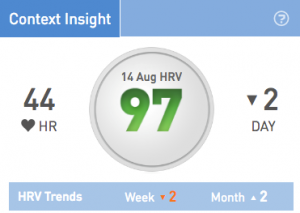There are many great reasons to choose ithlete, so many that we’ve written a blog series looking at why we do things the way we do. Follow the series to learn more about the type and length of measurement, how breathing influences your HRV and much more.
When designing ithlete in 2009, we homed in on a particular HRV measure known as RMSSD. It had the qualities we were looking for and can produce a valid HRV measure in just one minute.
The raw RMSSD HRV numbers are not very friendly though – either to individual users or to the maths we would like to do to create a baseline and identify significant changes.
For example, a healthy adult would have an average RMSSD of 35ms, an older or less healthy person an RMSSD of 20ms, but a triathlete could have an RMSSD of 130ms. The distribution of raw RMSSD is skewed, i.e. the differences on the up side are much greater than the differences on the down side. To correct for this, we take the natural log of the raw number. That gives us a more even or ‘normal’ distribution. The only problem now is that the numbers, e.g. 3.5, 3.0, 4.9 from the previous examples are still not very user friendly, so we chose to multiply by 20, which gives us a couple of nice benefits:
 An approximately 100-point scale.
An approximately 100-point scale.
Higher numbers are better and have an immediate impact on the user. Even without knowing exactly what it means users are pleased with anything above 70 (healthy HRV), and they see room for improvement below 60 (less healthy). Numbers above 80 indicate high levels of health and fitness whereas those below 50 are a cause for health concern.
- No need for a decimal point.
The difference of one point on the scale is 5%, which corresponds to the smallest worthwhile change for the LnRMSSD measure. Again this makes the value more user friendly.
The ithlete number scale* has been used in other HRV apps, such as Bioforce, ReVita5, Metafit, PUSH Vital Signs.
*Note: lnRMSSDx20 is a patented formula and therefore those interested in using this commercially must acquire a licence from HRV Fit Ltd.

As. 75 year old long distance road runner(closing in on 91,000 logged running miles). I have used the Oura Ring 2 and the Whoop Strap 2.0 and see my HRV between 15-20. I run 40-50 miles a week and have done that over the last 43 years. I realize each of us is unique, but when I see articles about HRV below 50 being problematic, I am a little skeptical. Sadly algorithms the aforementioned devices use are weak because there are not a lot of 75 year old runners who run and race like I do. Your thoughts.
Thinking of getting your device. You realize I am a data geek. Thanks for any info you can provide. Nick Nichols
Hello Nick. Glad to hear you are still going strong at 75. The fact that you are probably shows you know a bit about recovery already, especially since runners are so prone to overuse injuries. For HRV, we use a measure called RMSSD, and the way we do it is well described in this article by Dr Andrew Flatt, who is one of the gurus of HRV monitoring in sport hrvtraining.com/2013/07/04/rmssd-the-hrv-value-provided-by-ithlete-and-bioforce/
I’m not sure what measures and units the two devices you are using report in, but the fact that you see values between 15-20 suggests that it is either raw RMSSD or another measure. The makers of devices should state this clearly, and also their products should be independently validated, otherwise you only have their word that they work & are accurate. ithlete has been independently validated multiple times, and is now being used in medical research, so you should be able to trust it. We also have a large number of articles on using HRV in training on our blog http://www.myithlete.com/blog which discuss algorithms, and physiology. Hope you find this interesting, please report back on what you conclude! Simon.
Thank you for explaining your HRV scale here but I’m struggling to understand it completely. I measure my HRV with ithlete and I also monitor it with a device which uses RMSSD. I’ve only recently bought the second device and am still assessing its accuracy so it would be great to compare to my ithlete numbers.
My ithlete usually has me at around 80 – 90, how would this translate into RMSSD? Obviously I can divide by 20 but I’m not sure what next..
Hi Amber,
Although we think the ithlete scale makes more sense, some manufacturers do use a raw RMSSD scale. We start with raw RMSSD, take the natural log (Ln) then multiply by 20. So if you want to convert back first divide by 20, then take the anti-log e^x or Exp as it’s commonly known. 80 on the ithlete scale corresponds to 55ms RMSSD, and 90 on the ithlete scale by coincidence corresponds to 90ms RMSSD. Quite a big difference which is why we chose the log scale. Hope this helps!
Best, Laura